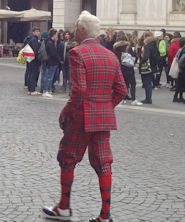
Dwight Peck's personal website
Ten days in the Veneto (without Venice)
February - March 2017
You may not find this terribly rewarding unless you're included here, so this is a good time for casual and random browsers to turn back before they get too caught up in the sweep and majesty of the proceedings and can't let go.
Padua walkabout

We've just been visiting the Scrovegni Chapel and Civic Museum at the northern end of the old town, and it's time to proceed downtown along the principal north-south thoroughfare, here called the Corso Garibaldi. 2 March 2017.
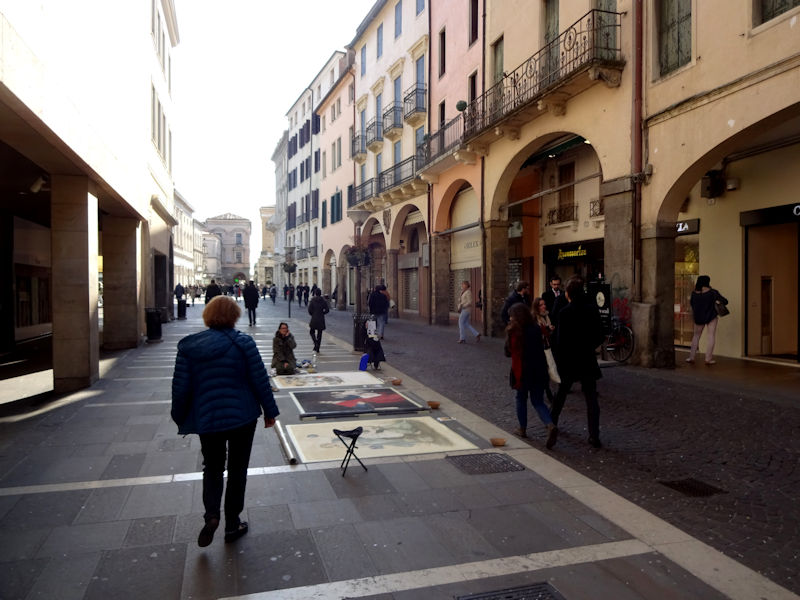
Street artists at work. Venice, now a thriving city of more than 200,000 souls, began life perhaps as early as the 11th century BC, when the river Brenta flowed closer to the centre than it does now. The Veneti of the town were evidently able to keep the Etruscan expansion at bay, and in the late 3rd century B.C. signed reliably up to the Roman project by assisting the legionaries against the Gaulish and Carthaginian invasions.
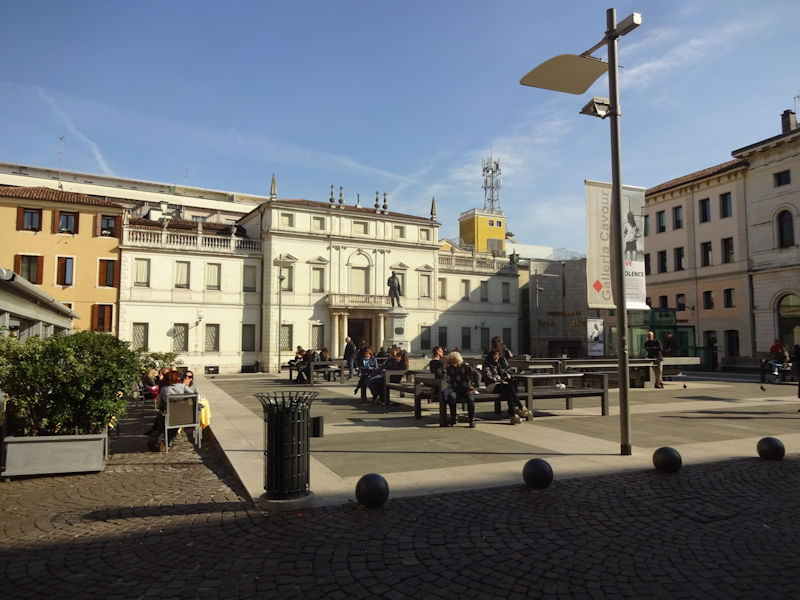
The Piazza Cavour. In 91 B.C., Padua (then Patavium) took the Roman side in the Social War, and in the 40s B.C. it was made a municipium, known widely for the quality of its horses, and said to be the second wealthiest city in Italy after Rome itself. The historian Livy exalts Padua and its culture immoderately, but he was born here.

Piazzetta Cappellato Pedrocchi (and the Caffè Pedrocchi). Somewhat later, the city was sacked by Attila's Huns in A.D. 450 and recovered only slowly. It suffered badly, from marauders and plague, during the Gothic War, conquered by the Byzantines in 540, then by Totila's Goths, then Narses' Byzantines again, and finally by the Lombard invasion in 568. Much of the population pulled out and headed for the inaccessible marshes of the Venice Lagoon (thereby founding, eventually, the city of Venice).
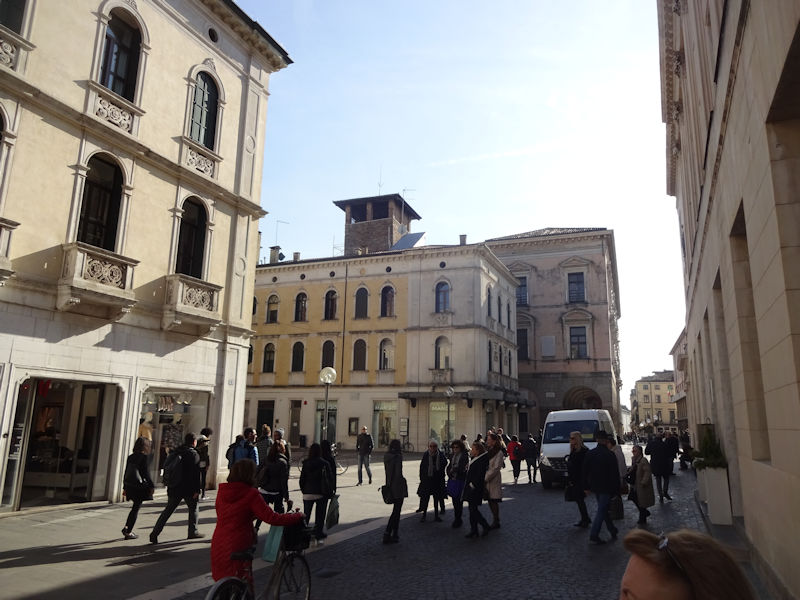
Those who remained underwent a 12-year siege by the Lombard rulers and the city got burnt to the ground in the early 7th century, and then got sacked again by the Hungarian Magyars in 899. For the rest of the first millennium, Padua pursued an unremarkable course during the period of the rule of bishops.

The Piazza Garzeria along the same street, which is now called the Via VIII Febbraio. Padua established its own constitution early in the 11th century and established consular administration in 1138; in 1178 it hired its first podestà to mediate amongst rising family factions. In 1236, however, the Emperor Frederick II's Imperial Vicar in the region, Ezzelino III da Romano, took over Padua and other cities in the region and behaved very badly for the next two decades. Generally, though, the city flourished in the 13th century, establishing Italy's second oldest university before 1222, for example, and beginning its long career as a centre of scholarly and artistic excellence (the university was founded by students and faculty of the University of Bologna seeking greater academic freedom).

For Padua, the Da Carrara family framed the 14th century, from Jacopo I's election as lord of the city in 1318 through nine Carraresi successors into the next century, except for brief periods under the Veronese Scaligeri in the 1330s and Giangaleazzo Visconti of Milan in 1388-90. Then came Venetian rule, here as elsewhere in the Veneto in 1405, through to the Napoleonic era, save for an historical instant during the War of the League of Cambrai when Imperial troops briefly occupied the city in 1509 but lost it to the Venetians again in the "Siege of Padua". Fans of Hawkwood are already aware that in 1387 the English condottiere known here as "Giovanni Acuto" ('John the Smart') led Paduan troops, with Francesco Novello da Carrara, in a significant victory over the Veronese at the Battle of Castagnaro southwest of the city (F. S. Saunders, Hawkwood: The Diabolical Englishman (2004), publ. in USA as The devil's broker).

This is the super-world-famous huge Caffè Pedrocchi (the southern end), established in 1772 with the present neoclassical building inaugurated in the 1830s -- countless writers sat there drinking expensive coffee and writing their stuff, including Stendhal, Byron, and Dario Fo.
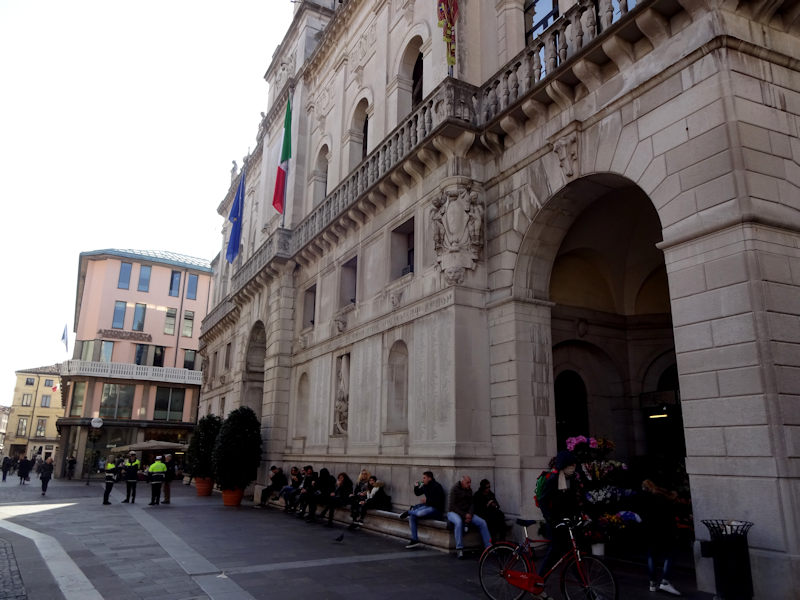
The Palazzo Moroni, present home of the city's administrative offices on the Via VIII Febbraio -- a huge complex connected to the medieval Palazzo della Ragione, Palazzo del Podestà, and other palazzi in the back. This front wing was completed in 1932.
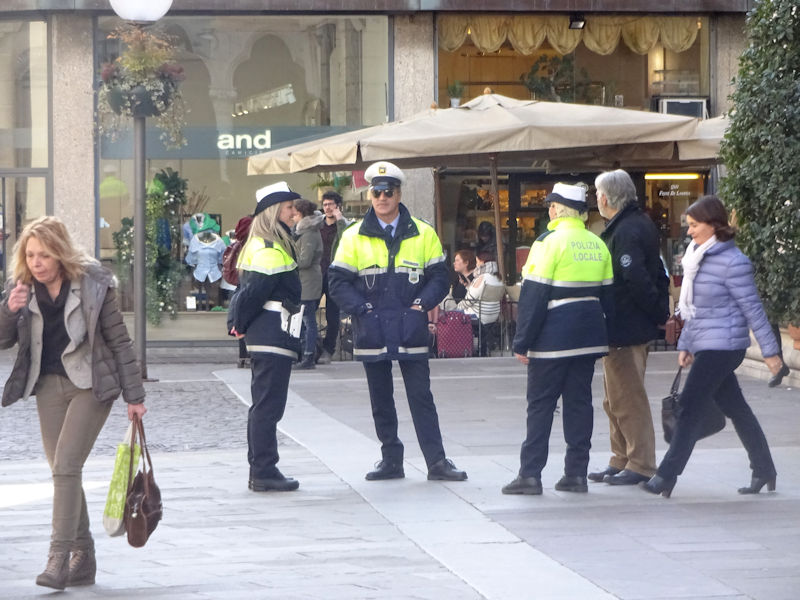
A benign police presence in front of the government building

Turning off in front of the Pedrocchi, and the adjacent neogothic 'Pedrocchino', to find the Palazzo della Ragione in the next street
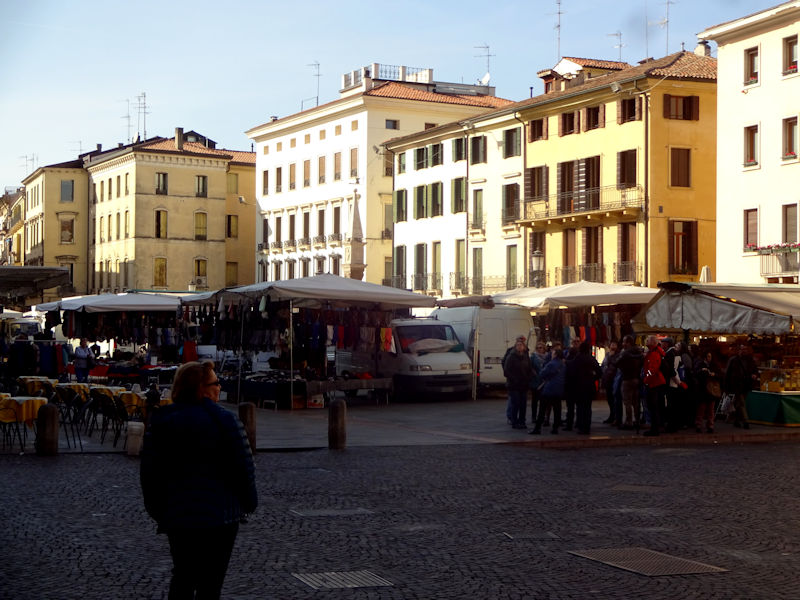
A street market in one of the main piazze, the Piazza della Frutta

The Palazzo della Ragione, or Palace of Reason, i.e., the medieval venue of the city courts and assembly hall of the city council

On a fine March day in the huge Piazza della Frutta (aka dei Frutti, the ancient fruit and vegetable market), with the Piazza delle Erbe on the far side of the Palazzo della Ragione the commercial centre of the city since forever

The Palazzo della Ragione was begun in 1172 and completed in 1218 -- a guy named Brother John (Fra Giovanni) added what became the single roof in 1306, said to be the largest roof without internal supports in Europe (it was destroyed by a tornado and replaced in 1756). At that time (1306-1308), Giovanni degli Eremitani caused the three first floor rooms to be converted into a single huge 'salon' or meeting hall.
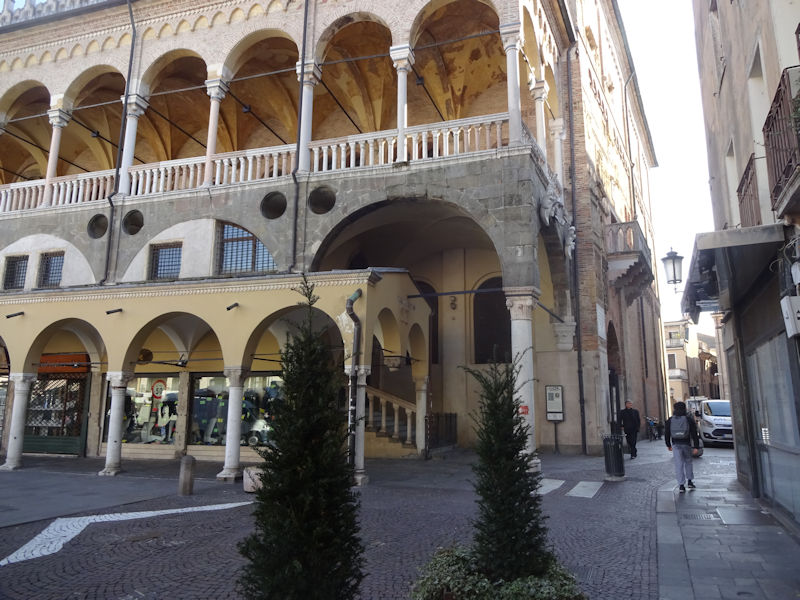
The grand hall stretches along the loggia on the first floor and is presently used for civic exhibitions. Giotto frescoed the original building but his works were destroyed in a fire in 1420; they were restored soon after by local artists and are open to the public now. Permanent market stalls were built along the ground floor and remain as commercial shops today.

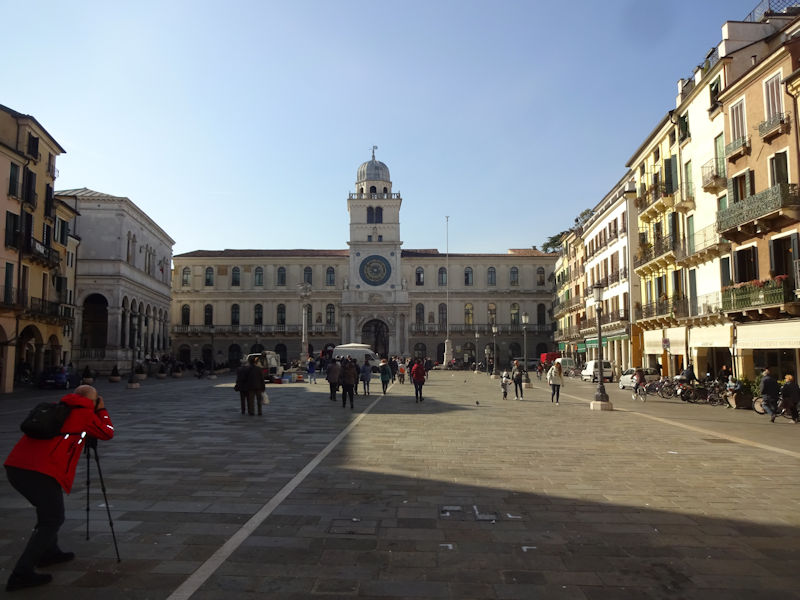
The next huge piazza, 70m farther to the west, is the Piazza dei Signori, a more offically civic space than the commercial facilities of the Piazza dei Frutti, established by the Carraresi in the 14th century for government buildings at the expense of a residential quarter formerly on the spot.
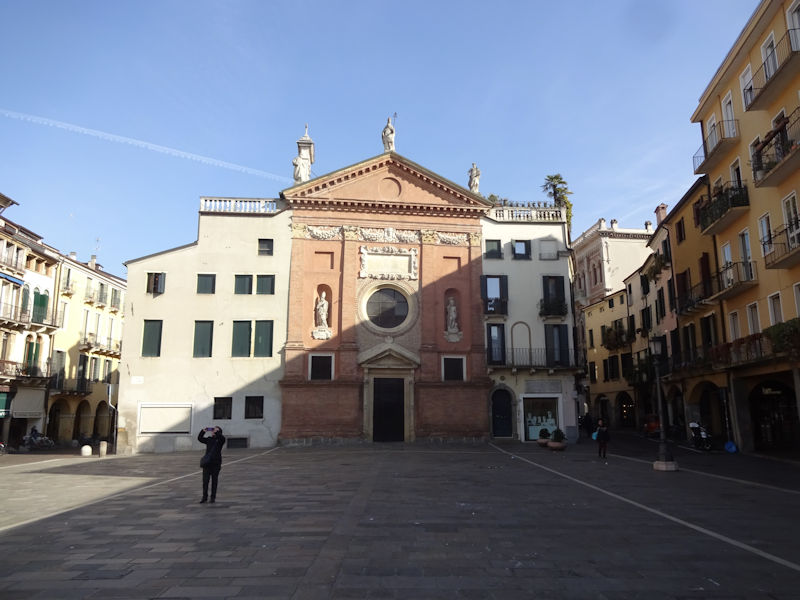
The Church of San Clemente presently dominates one end of the piazza -- first mentioned in 1190, it was substantially revised in the 16th century, and presently only the façade faces out to the grand public, with commercial buildings hemming it in on all sides.

The Clock Tower (Torre dell'Orologio) was built between 1426 and 1430, with the clock inaugurated in 1437, to replace an old gateway and unite the two palaces on either side of it. The present gateway was added in 1532.
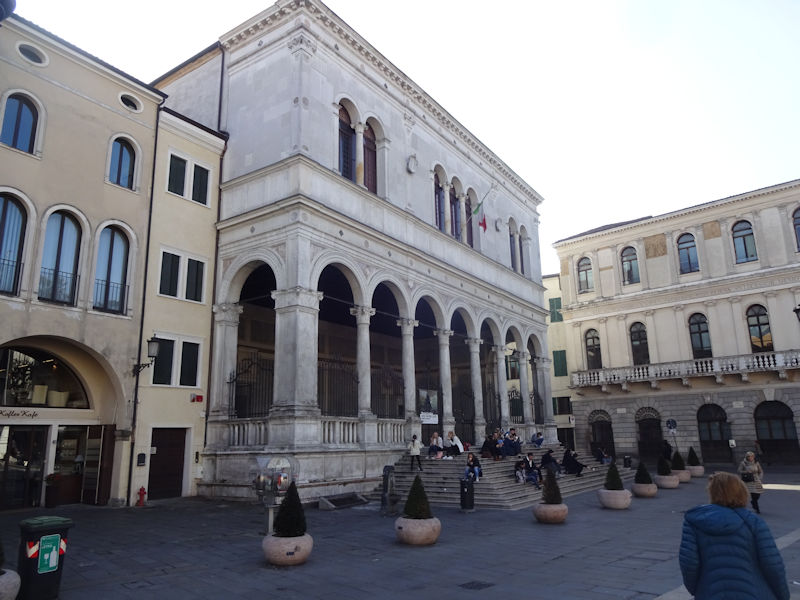
The late 15th century Loggia della Gran Guardia, or Guards' Lodge, was originally a city council meeting hall but acquired its present name from its use by the Austrians for a military command centre in the 19th century.
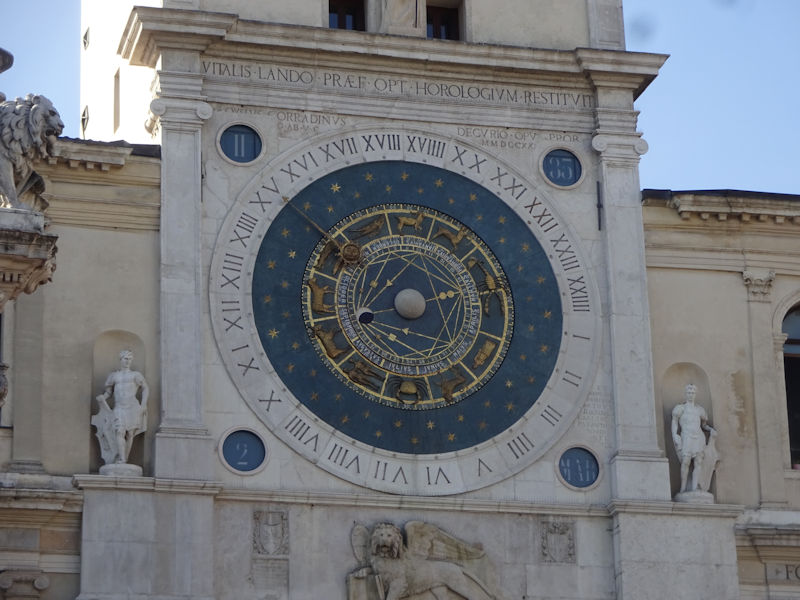
The original zodiacal clock was evidently installed in the palace next door in 1344 at the instance of the then-lord of Padua Ubertino da Carrara, but was destroyed in the 1390s by either the Milanese or the Venetians and replaced in the next century.
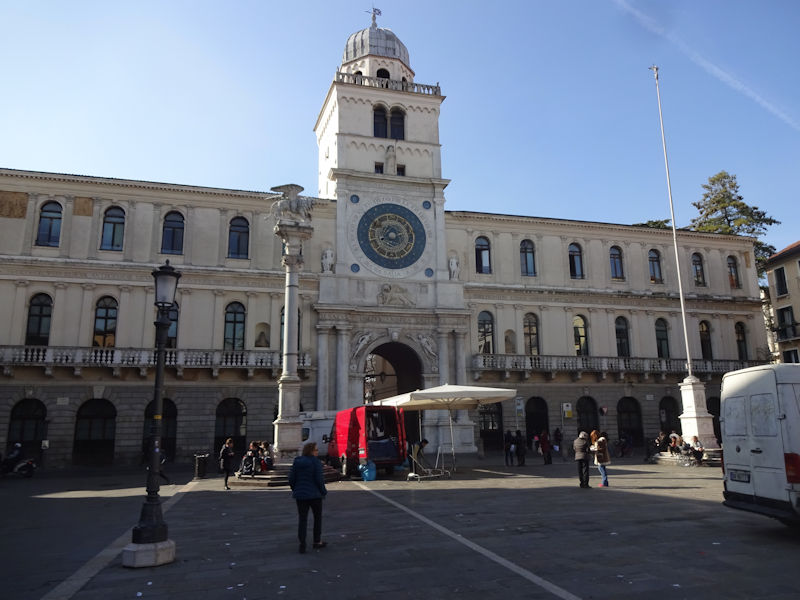
Now we're looking for the Duomo. Maybe it's through here.

Briefly lost in the Piazza Capitaniato with more university buildings, we're coming at the Duomo di Padova from the back end.
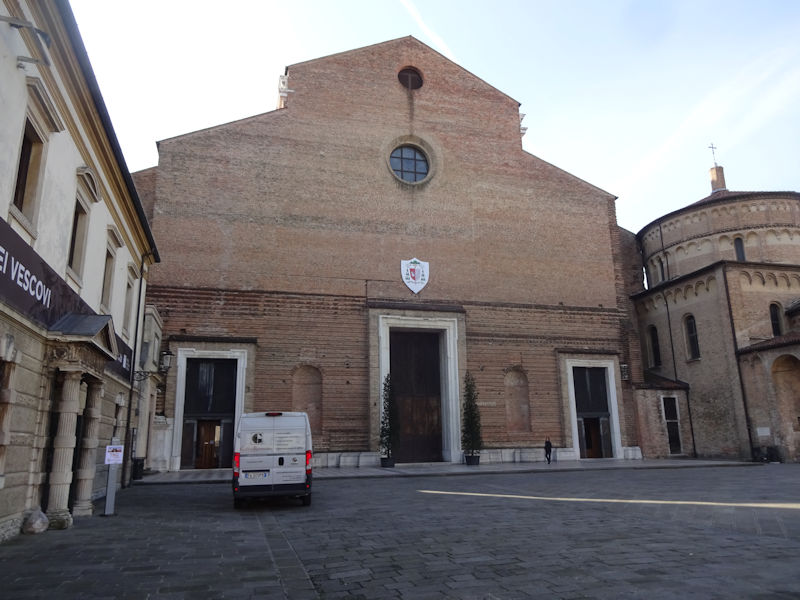
The Cathedral of Padua, properly the Basilica Cattedrale di Santa Maria Assunta -- the first cathedral on the site was supposedly built right after Emperor Constantine's pro-Christian Edict of Milan in 313; when that one was destroyed by the 'Verona Earthquake' of 1117, it was replaced by a Romanesque edifice, consecrated in 1180, which can still be seen in the frescoes in the Baptistery just to the right -- that one was in turn to be replaced by the present building, inaugurated in 1582 but, as new bits gradually superseded the old ones, only completed in 1754, the dome after that, and the façade never.
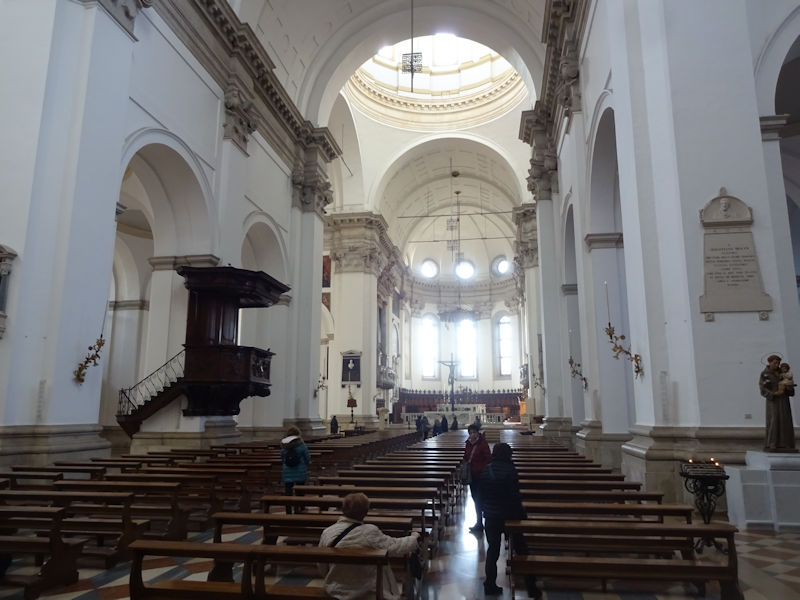
The interior is a nave with two aisles in a Latin cross with a large circular dome over the crossing. There is an apparently contested view that Michelangelo created the design for it, but wasn't involved in the work.
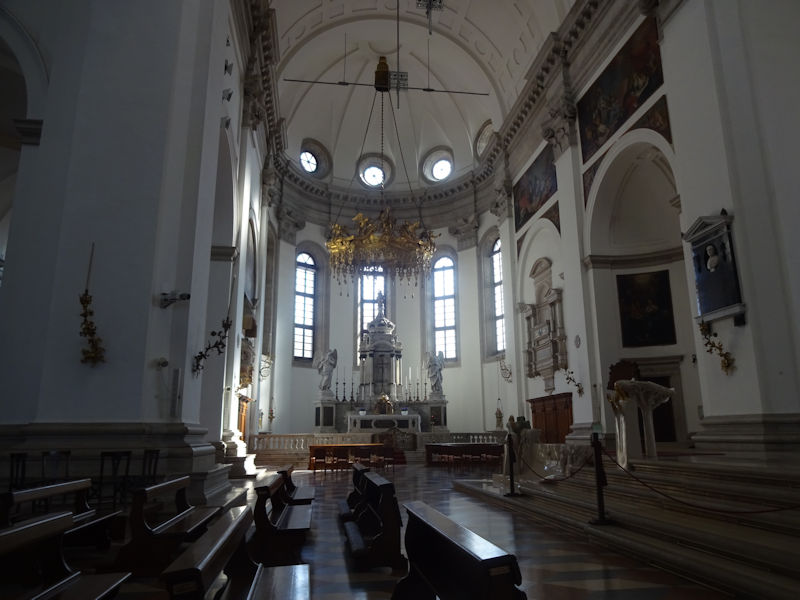
Small chapels line the side aisles, with larger chapels in the transept.
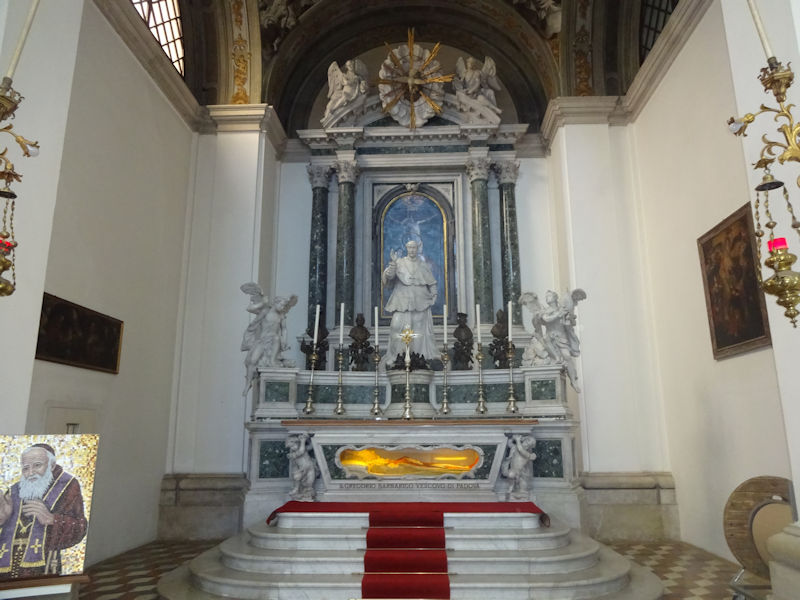
One of Padua's bishops

Across the Piazza di Duomo, on the left is the Palazzo del Monte di Pietà Nuovo, in the 14th century a part of the Da Carrara family's holdings but in the 16th century turned over to the "Monte di Pietà" financial institution founded by the Franciscans to help relieve the poverty of the urban poor with small low-interest loans, a role that a successor charitable foundation evidently still performs.
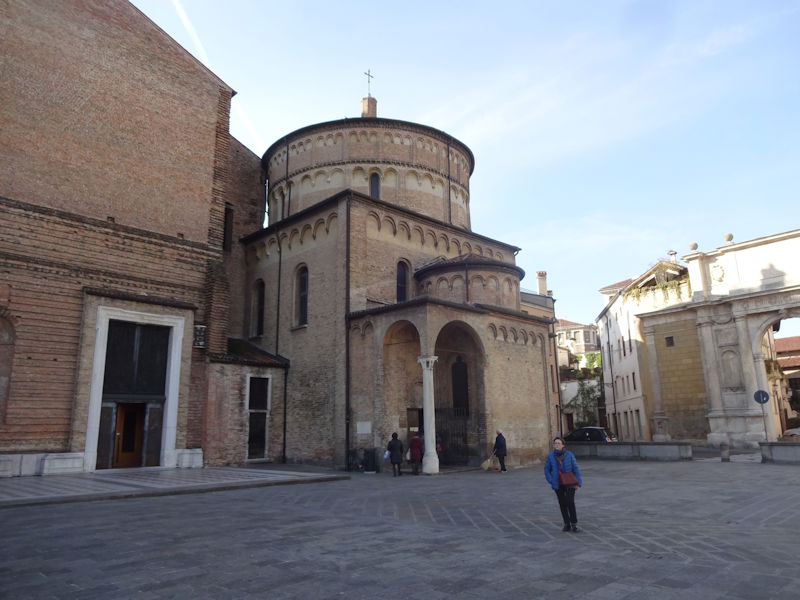
The Baptistery, dedicated to St John the Baptist as usual, was begun in the 12th century and consecrated in 1281; in the 1370s it was reconfigured as a family mausoleum by Francesco I, 'il Vecchio', da Carrara, but when the Venetians threw the Carraresi out in 1405 they demolished as much as they could of the funeral monuments.
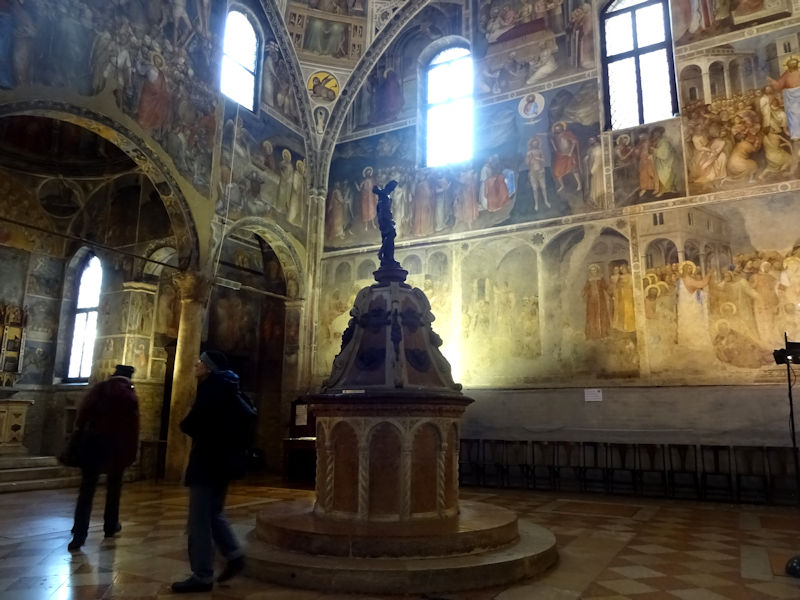
The frescoes featuring the lives of St John the Baptist, Jesus, and Mary were commissioned by Fina Buzzaccarini, the wife of Francesco I, and executed in 1375-78 by the Florentine Giusto de' Menabuoi, who also worked on Padua's Church of the Eremitani and the Basilica of Saint Anthony.
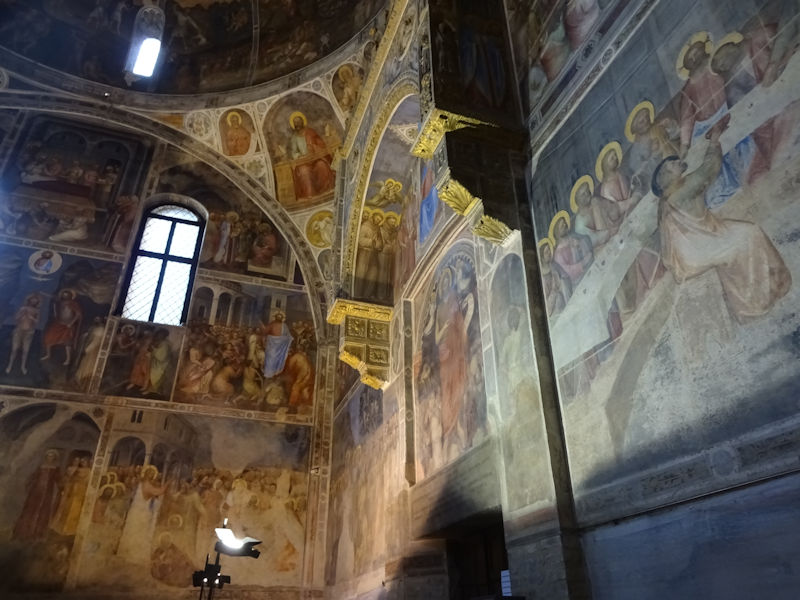
As always, appreciating fresco details ten meters above your head is a challenge.

Giusto is thought perhaps to have been a pupil of Giotto. The complicated and crowded 'Paradise' in the dome shows a Christ Pancrator surrounded by orderly crowds of angels and saints lined up like a high school graduation.
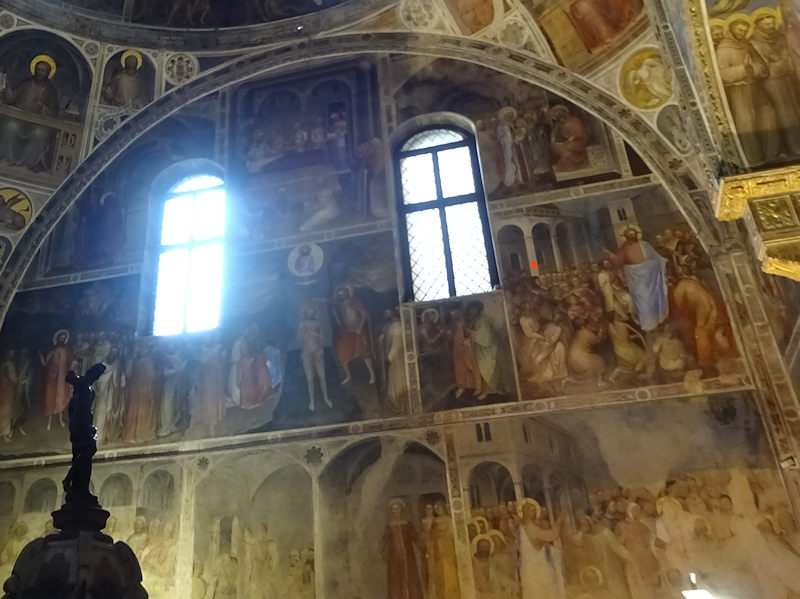
Amongst all the biblical and traditional subjects, we're told to squint hard and make out (just under my red dot) the faces in the crowd of Francesco I da Carrara and his wife Fina, with their good friend Francesco Petrarch.

The Piazza Duomo

Walking eastward along the Via dei Soncin, then heading south
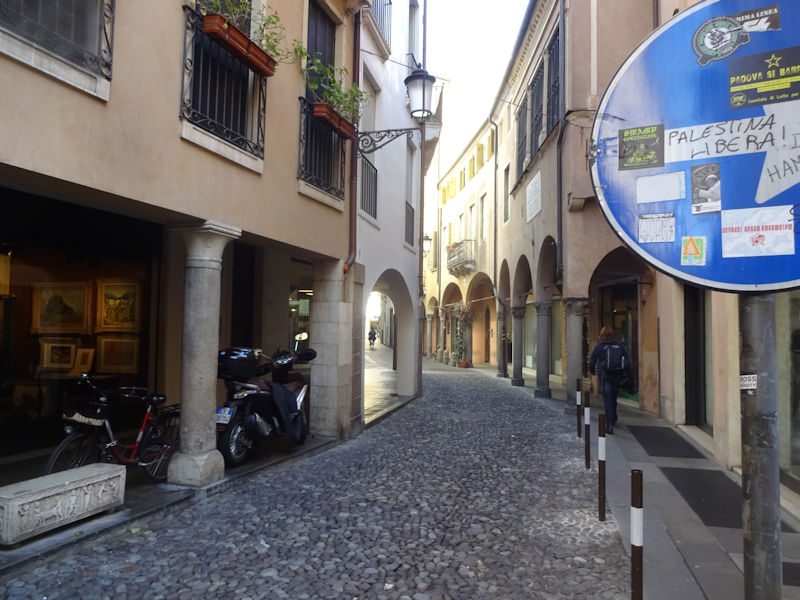
"Palestina Libera!" Well said.

Crossing the Ponte delle Toricelle over one of the surviving navigable canals, looking westward towards the Ponte Barbarigo

Along the Via Umberto I, leading to . . .
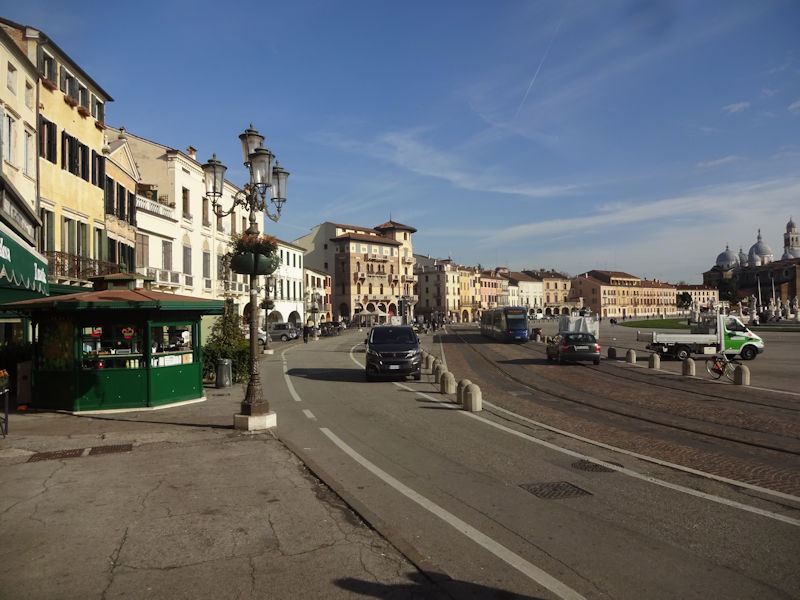
. . . the enormous Prato delle Valle, the largest piazza in Italy

The elliptical piazza was built over formerly swampy wasteland in the 17th century, first as a sort of jousting playground, apparently, but then beginning in the 1770s, under the direction of a man called Andrea Memmo, as an elaborately landscaped public space, with sophisticated waterworks around an artificial island ringed with 78 statues by various hands in two rings.

The Isola Memmia. The Prato delle Valle was let to languish over time but has been restored in the past two decades, creating a popular recreational and relaxing space for the population.
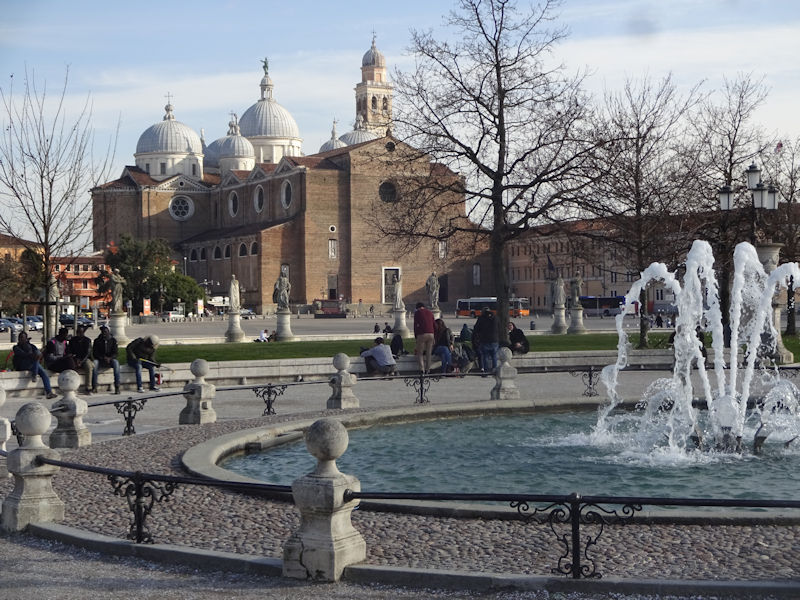
We're looking for the famous Basilica of St Anthony of Padua, a big church we're told, near the Prato delle Valle . . . so that must be it!!
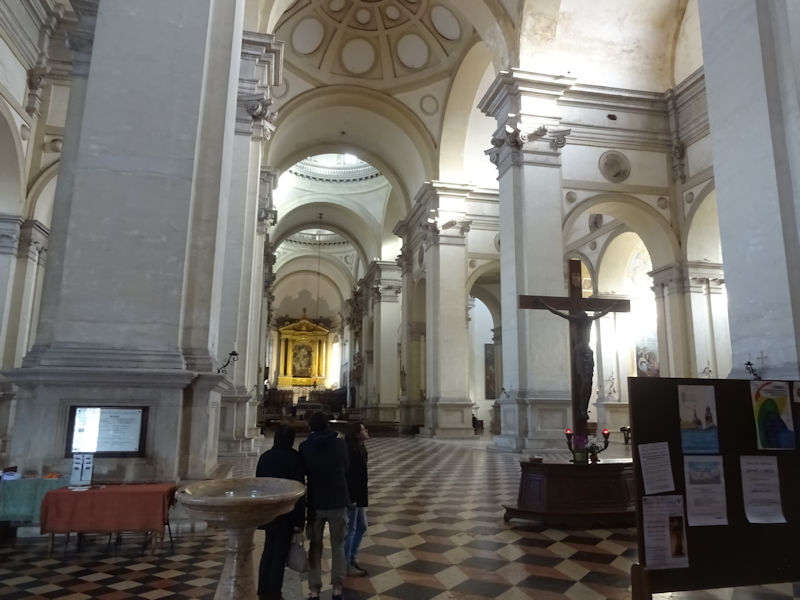
Oh no, it can't be. This, we discover, is the Basilica and Benedictine Abbey of Santa Giustina; both were established in the 520s but suffered earthquakes (like the big one in 1117) and numerous sackings until reconstructions in the 17th century. It's the seventh largest church in Italy, with a huge number of chapels, but the French carried off most of the artistic heritage and suppressed the community here after 1797, and the cloisters were used as Austrian military barracks throughout the 19th century. The Church regained it in the 20th century and it's apparently a functioning religious community again, as well as a national monument under the civil heritage authorities.

Kristin and a Griffin
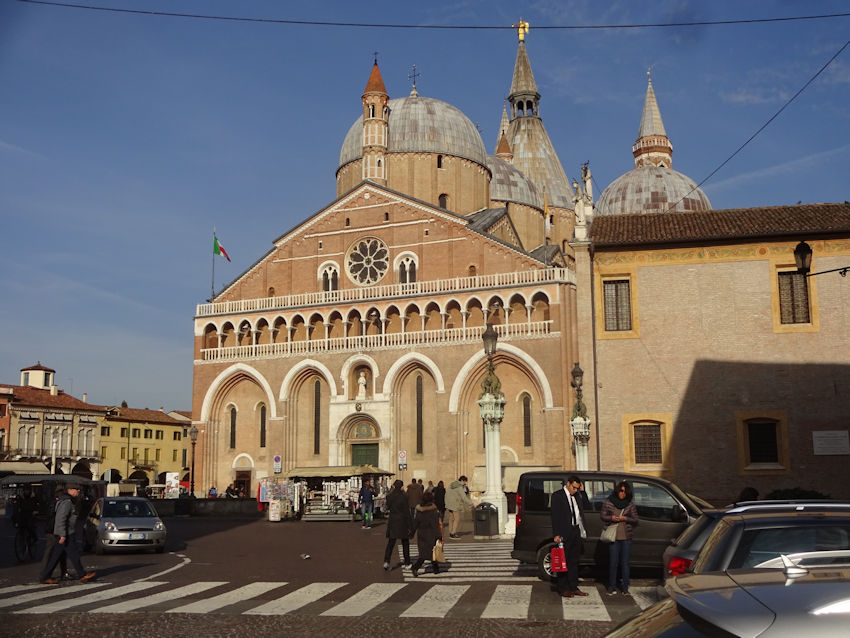
This time we've got it; went right past it. This is the Basilica of St Anthony of Padua (Basilica Pontificia di Sant'Antonio di Padova), popularly called il Santo. St Anthony was a Portuguese Franciscan who came to be known in Italy as a powerful preacher and trusted friend of St Francis of Assisi; he died in 1231 of ergotism (which came to be known as 'St Anthony's fire') and was canonized less than a year later. He was buried according to his wishes in a small chapel here, but in 1232 the Basilica was built up around it and completed in about 1310, with further modifications over the centuries.

Prominently placed in the piazza is a life-size equestrian statue of 'Gattamelata' (Erasmo da Narni), a well-known condottiere who fought for the Papacy, Florence, etc., but was serving as high commander of the Venetian armies when he was crippled by a stroke in 1440 and died in 1443 at 73. The statue, commissioned by Venice in 1453, is by Donatello and is said to be the first life-size bronze equestrian statue since classical times.

The Basilica began life as a single-nave Franciscan-style church, but later in the 13th century side aisles were added and suitable amendments made to the façade, namely the elegant Gothic recesses and the arcaded balcony across the front.

The nave looking towards the main altar
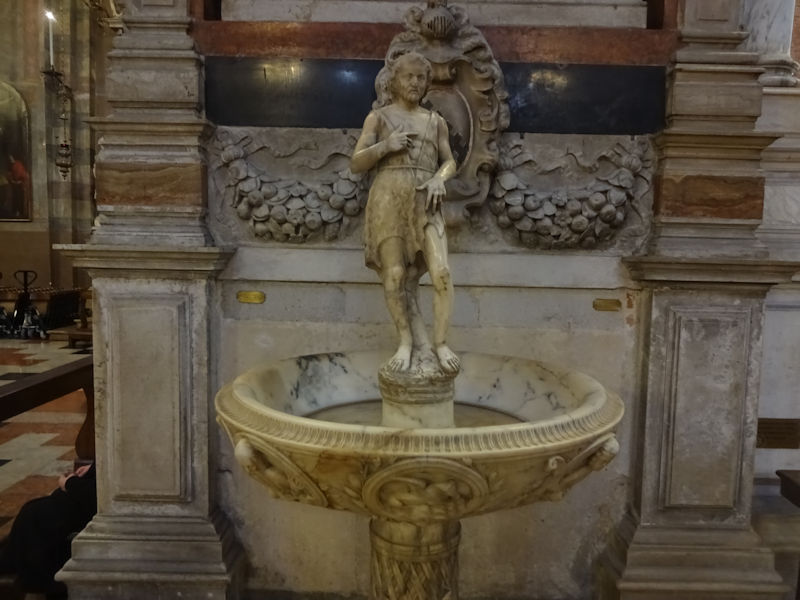
A baptismal font, presumably with John the Baptist on it in his wild man suit

The Cappella del Santissimo, with the tombs of Gattamelata and his son Giannantonio, commissioned by the soldier's widow in 1457
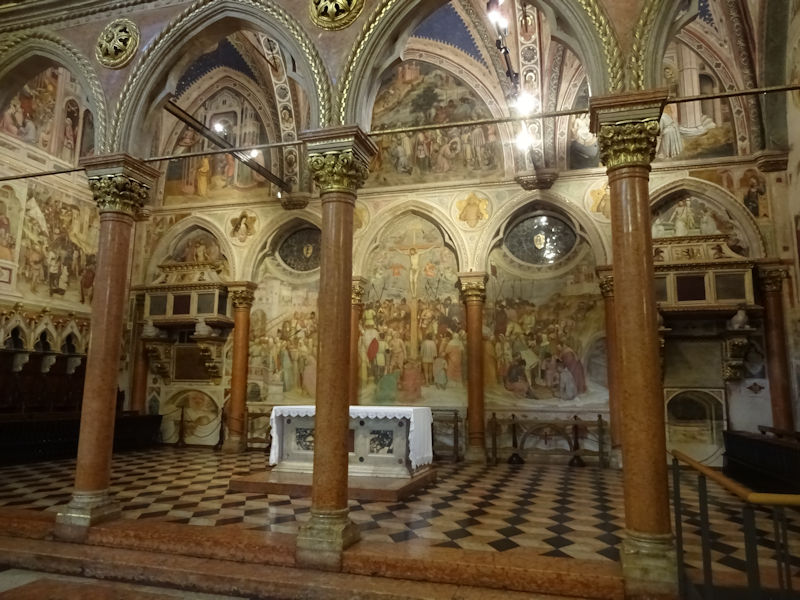
Farther along the right side of the nave, the Chapel of San Giacomo, or St James, commissioned in 1372 to replace an earlier chapel in that place.

Scenes from the life of St James, as recounted in Jacobus de Voragine's 13th century Golden Legend
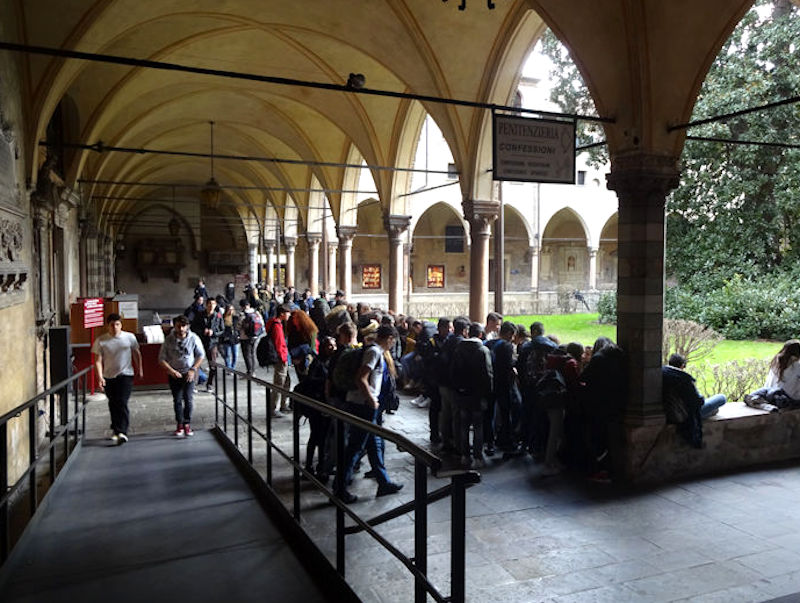
School children lined up eagerly to get at the Confessioni and the Penitenzieria

The Coronation of the Virgin Mary, by Giusto de' Menabuoi, late 14th century

The Chapel of the Reliquaries (St Anthony's tongue and tonsils are in that little spikey thing in the centre; he was a famous preacher, after all)
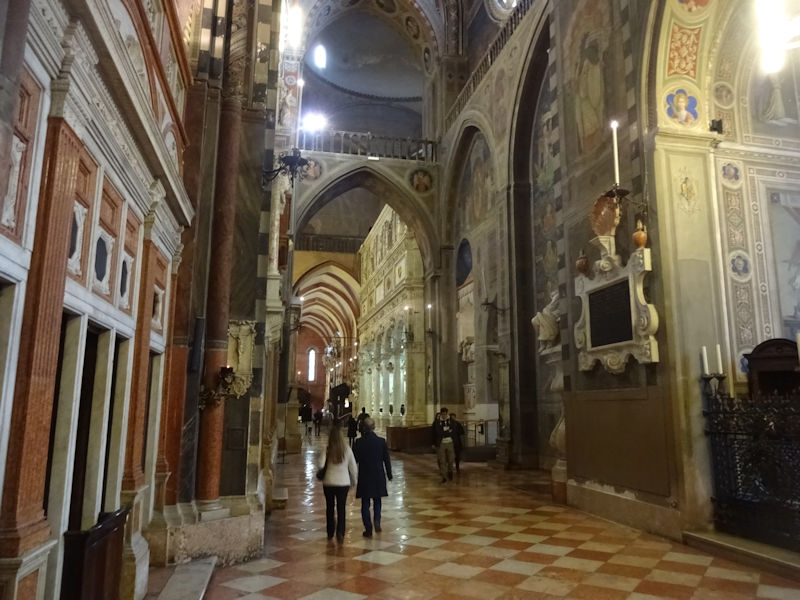
Continuing around the ambulatory behind the presbytery and main altar


The Chapel of the Madonna Mora ('swarthy madonna'), with a statue by the Frenchman Rainaldino di Puy-l'Evéque, about 1396. The late 12th century chapel was the original 'resting place' of good St Anthony until the huge Basilica was built up all round it, and the saint himself, patron saint of lost objects, was moved over to his own somewhat overstated tomb.
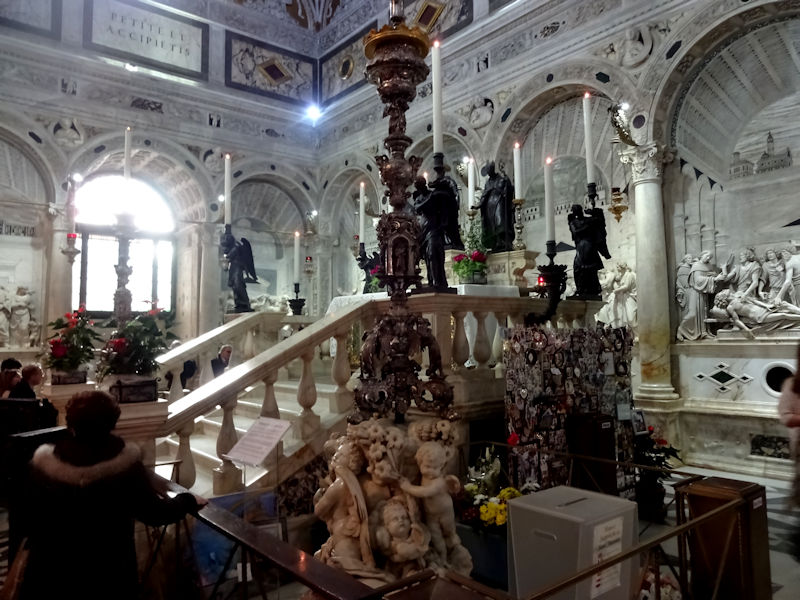
The tomb of St Anthony of Padua -- ooooff.
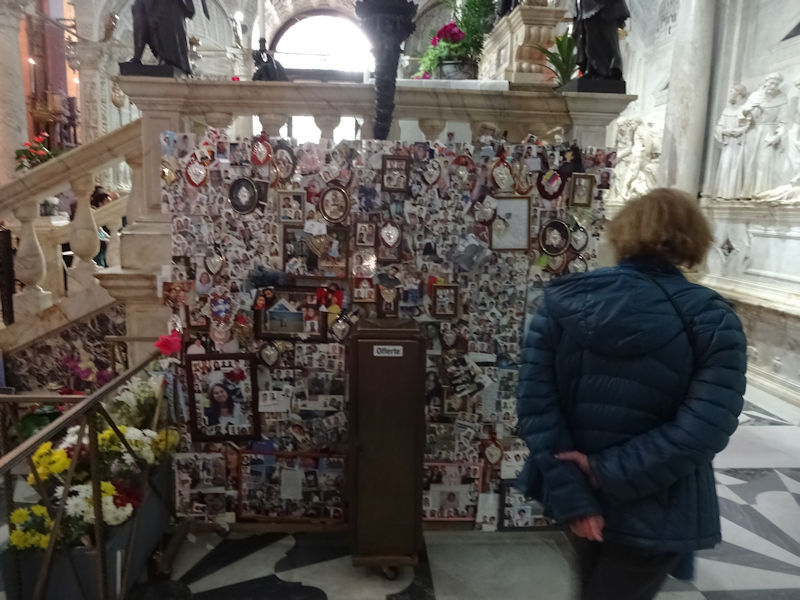
Hopes, dreams, heartfelt expressions of gratitude, and tearful pleas for forgiveness
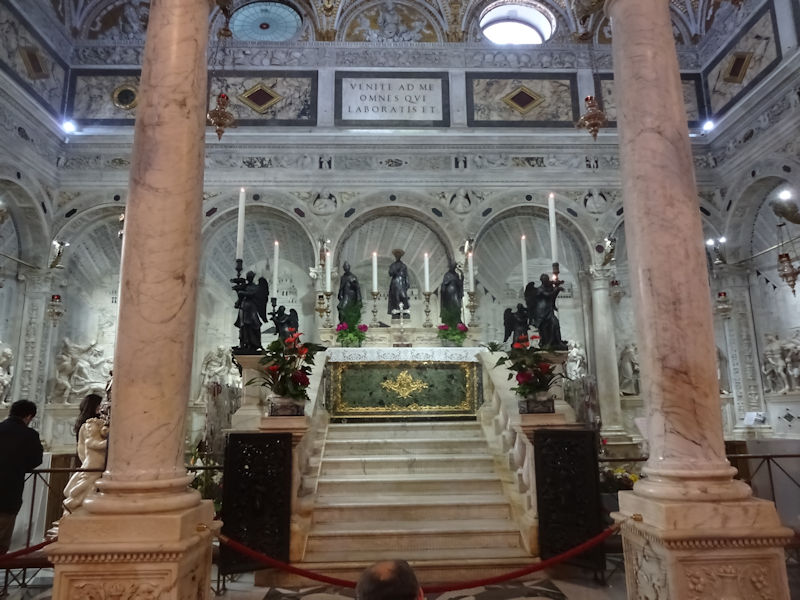
The Tomb of St Anthony. The saint's body was exhumed thirty years after his death, we're told, and it was a big pile of dust. Except for the tongue, which was glistening. So the tongue, and lower jaw, are what got into the reliquary.
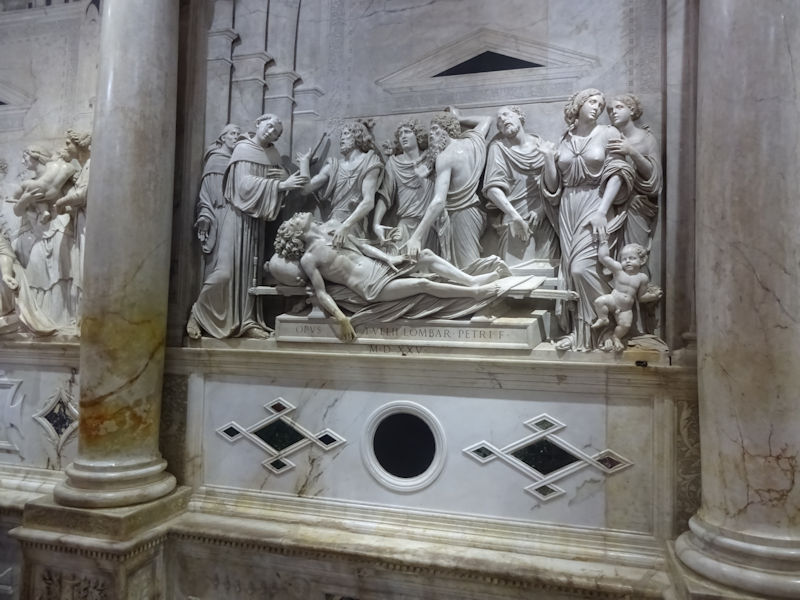
Around the walls are seven episodes of the life of St Anthony

The huge Chapel of St Anthony
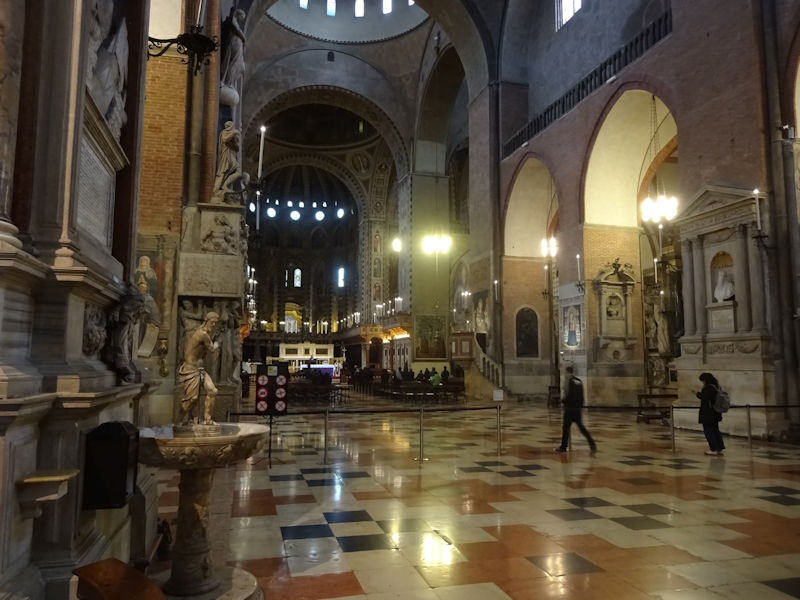
The high altar in the apse, with a bronze Crucifix of 1444–47 and six statues of saints by Donatello in the choir, 1446 to 1450, along with four reliefs with scenes from St Anthony's life for the high altar. There's religious business going on in there at the moment, so we'll get no closer without offending.

The Madonna of the Pillar, by Stefano da Ferrara, ca. 1350

The Scoletta or School of St Anthony is just a few doors from the Basilica, and if you ask nicely a gentleman in a religious suit will come along and unlock the front door for you. The ground floor was built in about 1430 and the upper one was added in 1504 as a meeting room for the Archconfraternity of St Anthony brotherhood.
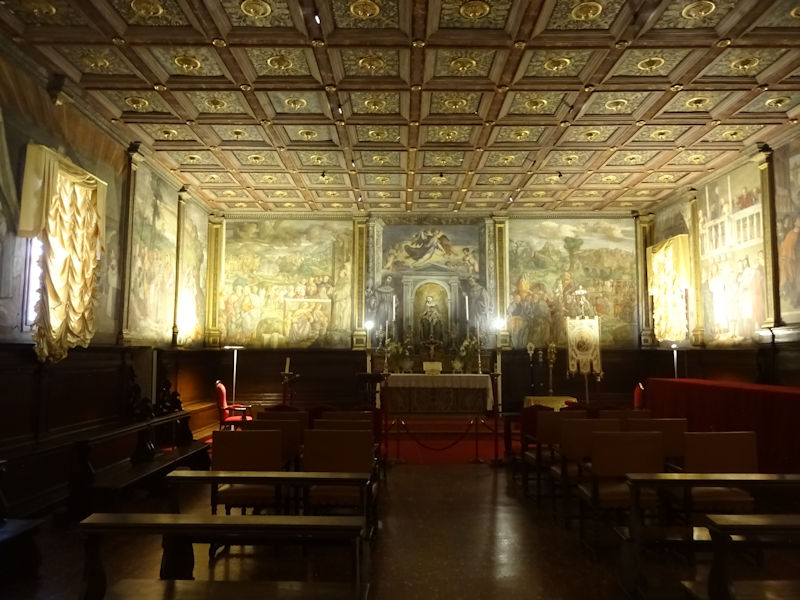
A small classroom sort of thing, it's got 15 fine frescoes and three canvases on the life of St Anthony of Padua all over the walls, and a very nice ceiling.
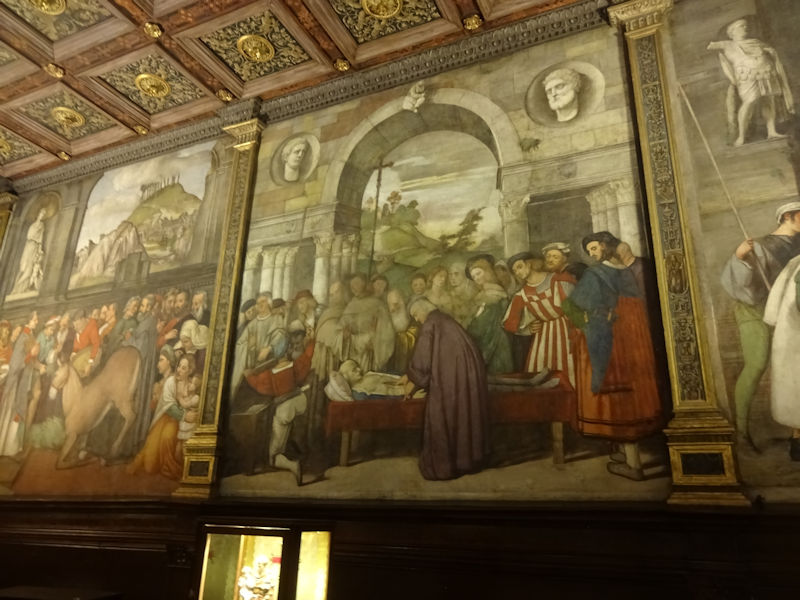
They all illustrate miracles attributed to St Anthony, most of which don't seem to make any sense. Here the saint has just discovered something inside a dead guy (attributed to Francesco Vecellio, 1512).
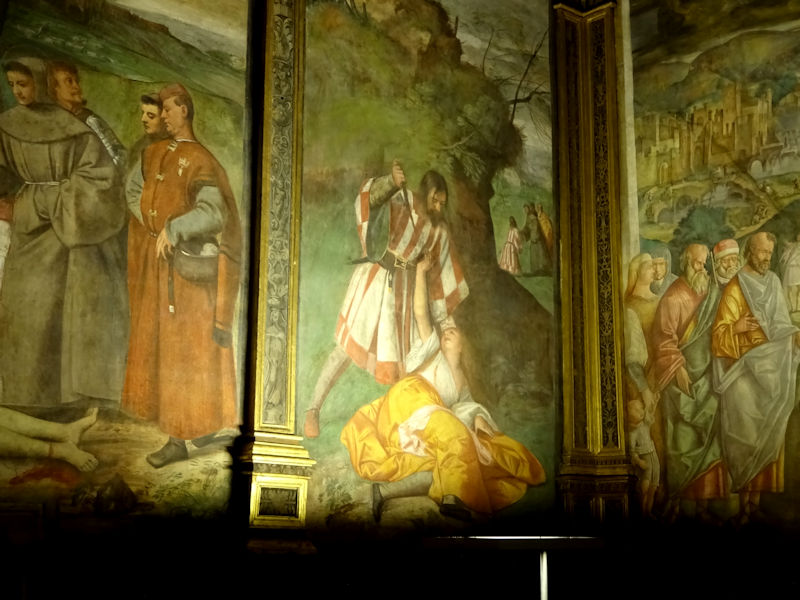
The 'Miracle of the jealous husband' is one of three by the young Titian, in 1511 (the repentant killer is seen kneeling at the feet of the saint in the background).
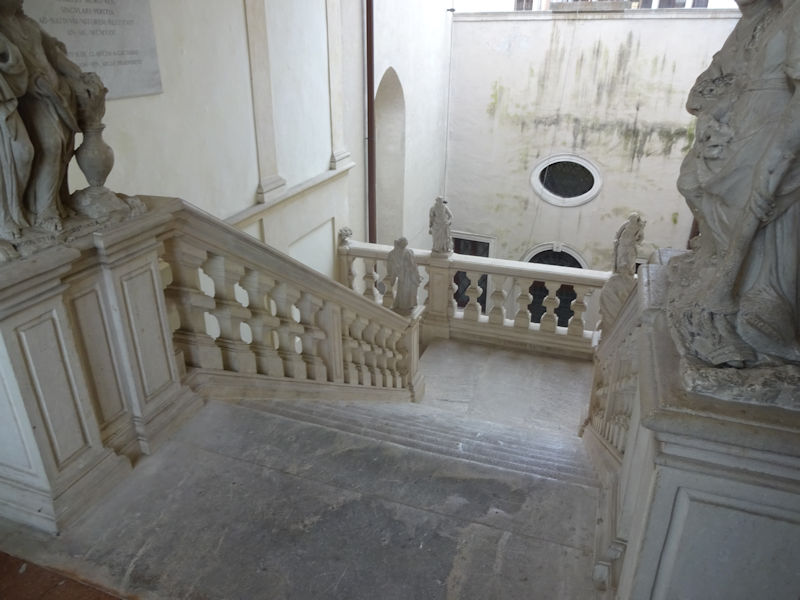
The nice staircase dates from the 18th century.
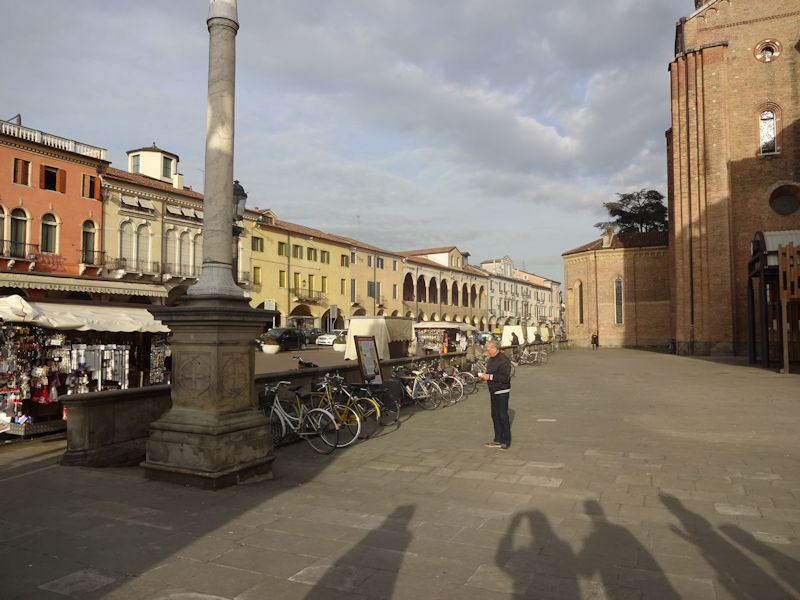
The Piazza del Santo

The Basilica of St Anthony from the north side, with some of its seven domes on display
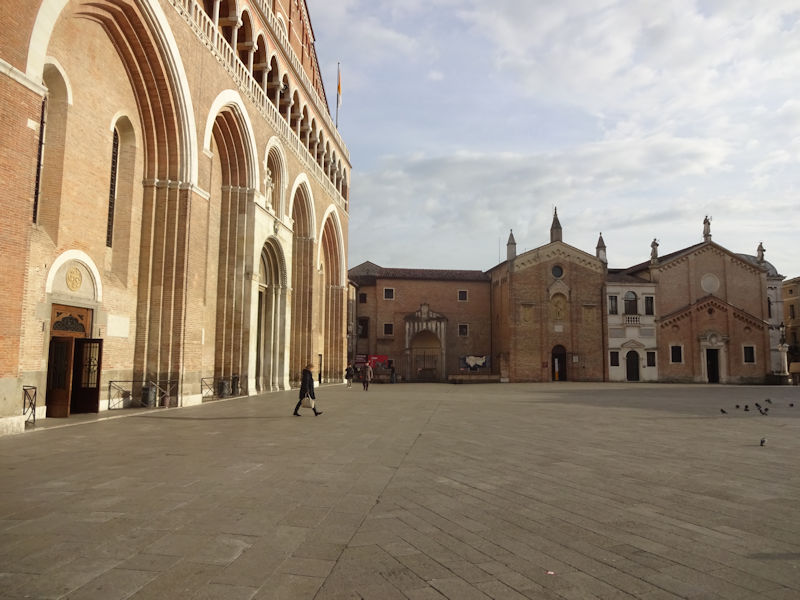
The front of the Basilica of St Anthony. The Scoletta, or Scuola del Santo, is the little white building squeezed in between some other sacred stuff. Popes used to greet crowds from that little first floor balcony, back in the day.
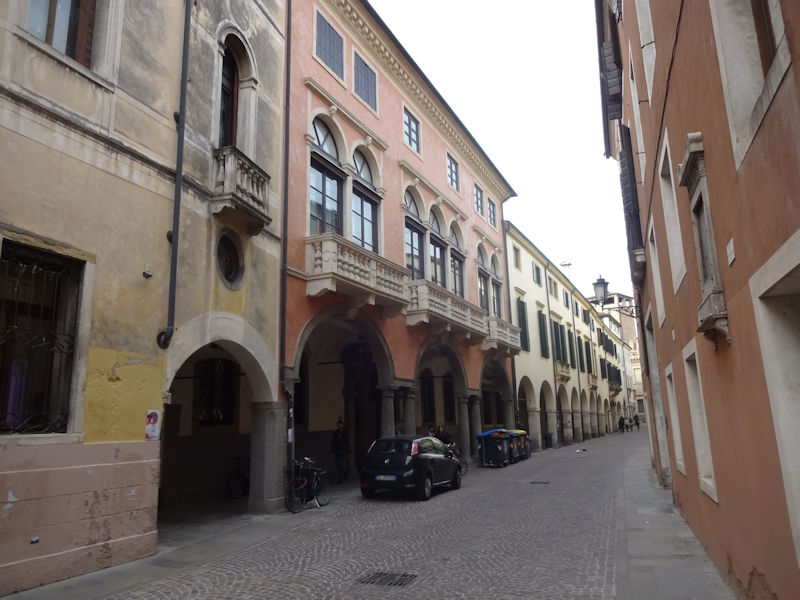
Street scene, walking northward up the Via del Santo

-- Thanks, it's too early in the day.
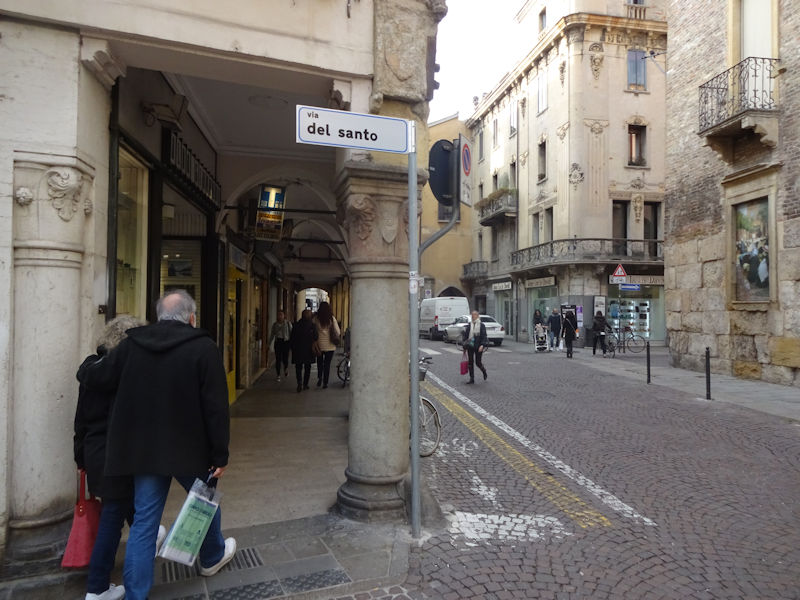
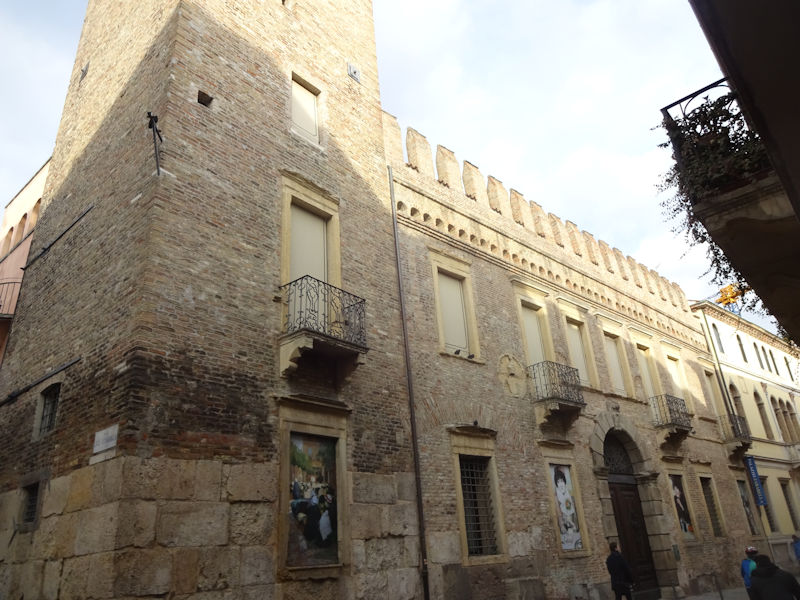
The crenellated Palazzo Zabarella on the Via San Francesco, acquired by the Zabarella family in the 14th century, is since 1997 the home of the non-profit Fondazione Bano to provide for artistic and cultural activities and exhibitions.

When this sarcophagus was dug up in 1274, the city fathers immediately realized that it was the tomb of Antenor, the Trojan prince who after the Fall of Troy in 1183 BC led his band of Trojans and their Asia Minor allies, the Veneti, to this place and founded the city of Padua (according to Vergil and Livy).
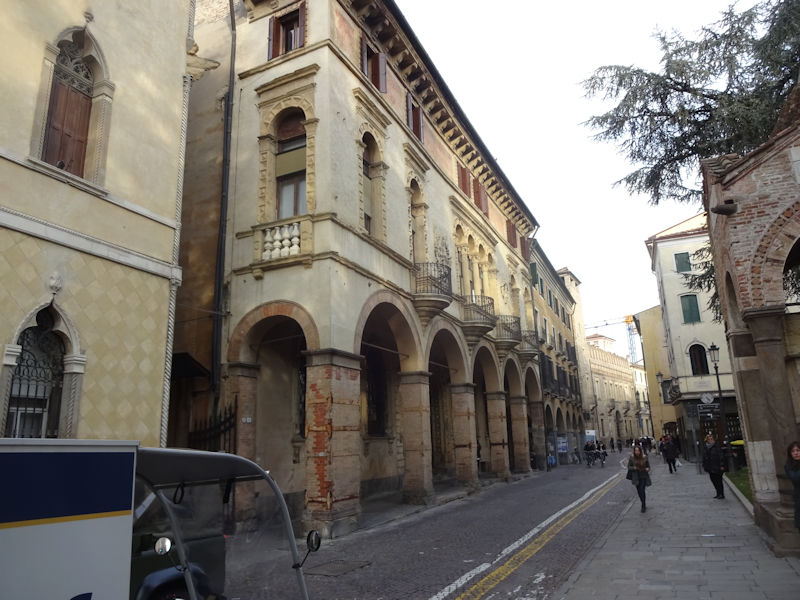
The Via San Francesco near the Tomba di Antenore
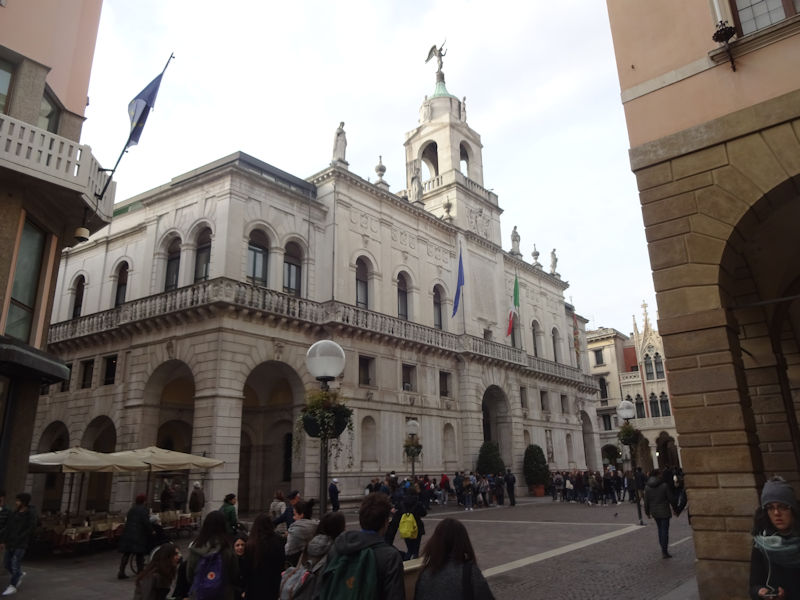
The city's municipal building on the Via VIII Febbraio, across from the Palazzo del Bo, the heart of the sprawling city university
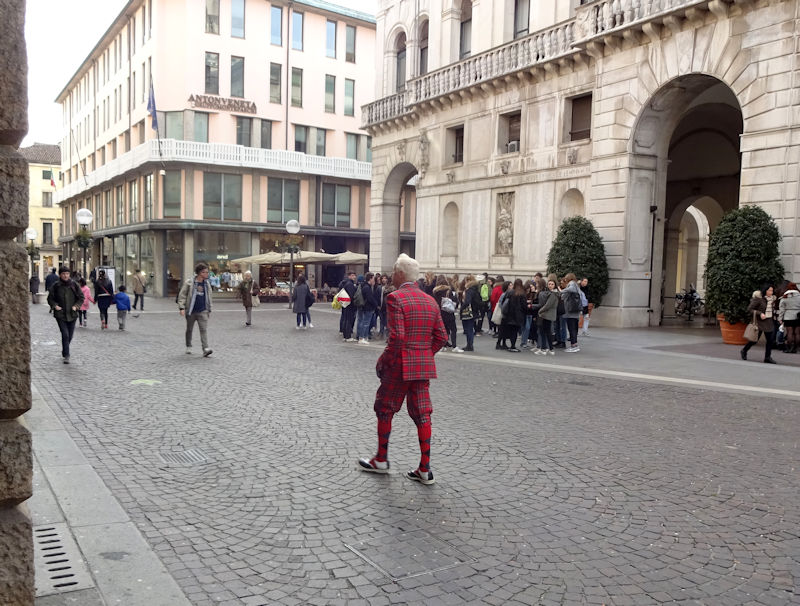
Fashion sense is not dead in contemporary Padua. Whilst Kristin's checking out the local pharmacy's daily bargains behind me, I'm standing in the archway of the Palazzo del Bo, since 1493 the historical centre of the University of Padua (with the world's first anatomical theatre), and never looked up.

The Via Cavour
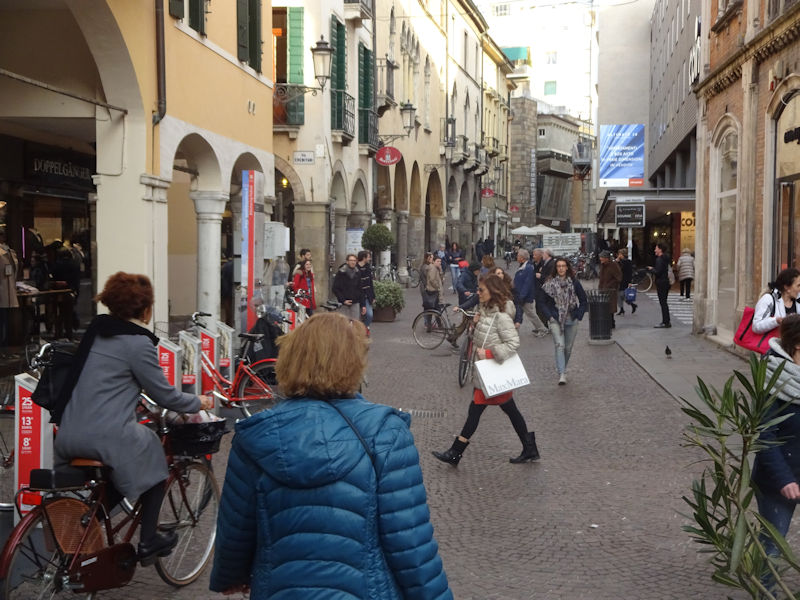
On the Via Altinati and . . .
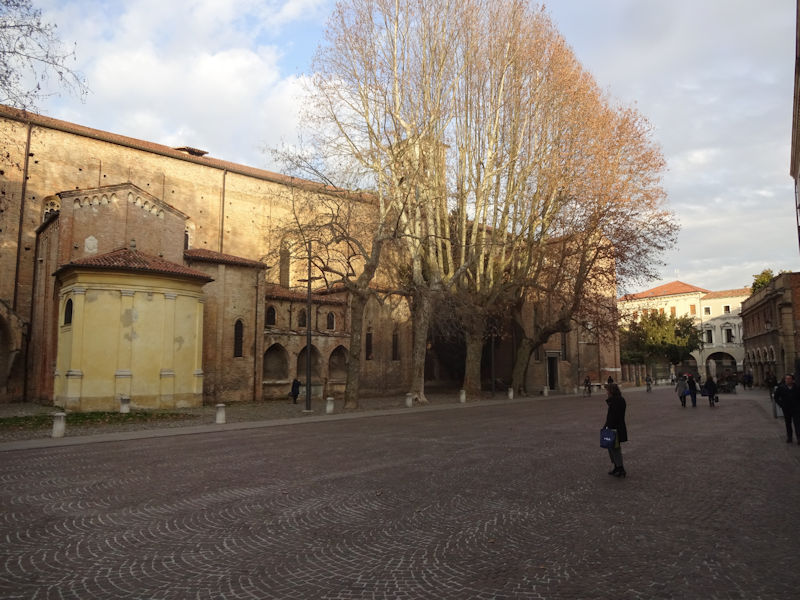
. . . passing the Church of the Eremitani to the carpark.
        
   

 Feedback
and suggestions are welcome if positive, resented if negative, Feedback
and suggestions are welcome if positive, resented if negative,  .
All rights reserved, all wrongs avenged. Posted 13 June 2017. .
All rights reserved, all wrongs avenged. Posted 13 June 2017.
|


































































































